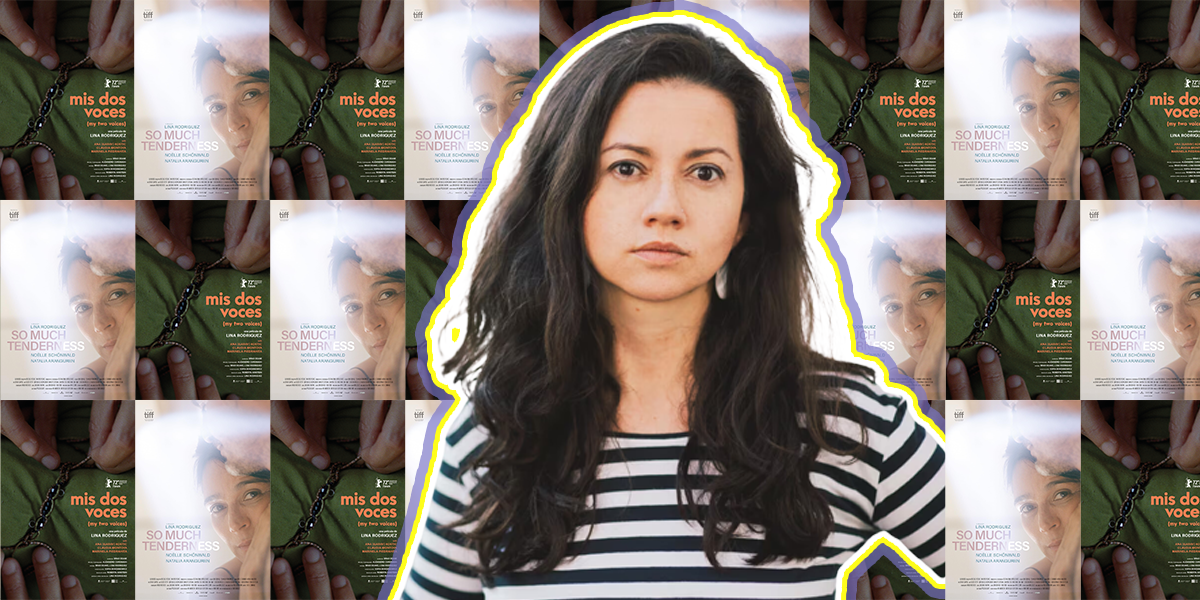In a heart-pounding, hold-your-breath moment, I watched two people look into each others’ eyes. One, a dark-haired Latina, slightly withholding, the other, an older white man, staring. They were sitting across from each other, unmoving, for too long. A kiss imminent, but somewhere still far away. The in-between was centerstage. While watching the third feature film by Colombian-Canadian filmmaker Lina Rodriguez, So Much Tenderness, I sat for an excruciating 4 minutes and 34 seconds within the awkward, sometimes cringe, sometimes soft, extremely charged gap between desire and doing.
So Much Tenderness, which premiered at the 2022 Toronto International Film Festival, follows a Colombian woman, Aurora, who’s fled to Toronto with Lucia, her daughter (the aforementioned Latina) after the murder of her husband. After a six-year time jump, Rodriguez allows for a delicate and fragmented immigrant narrative to unravel. Resisting the stereotypical “border-crossing” narrative loaded with violence, crime, and suffering, Rodriguez frames the film around subtle and complex performances by Noëlle Schonwald and Natalia Aranguren living fairly normal, middle-class lives.
Rodriguez’s scenes often meander and suspend in time, lasting longer than a director more concerned with plot than person might allow. Her choices force the viewer to settle in life’s strange, often competing emotions. What leaps out, as a result, is the undeniable feeling of unsettlement, manifesting repeatedly in ways gentle or bursting.
Rodriguez’s allegiance to the humanity of her subjects is also prominent in Mis Dos Voces, her 68-minute documentary that premiered at the 72nd Berlin International Film Festival in 2022. It features the stories of three Latin-American women immigrating to Canada. Here, Lina Rodriguez again counters a monolithic portrayal of the immigrant experience by presenting an “impressionistic tapestry” of intimate visuals and delicate soundscapes where the end of one woman’s narration and the beginning of the next become blurred and therefore, intertwined.
By weaving together intimate details in slow-moving frames of mundane domestic and work life like hands washing dishes, driving a bus, or doing a young girl’s hair, alongside gripping accounts of displacement scattered across multiple timelines, Rodriguez forces the viewer to grapple with the messy reality of ever-shifting identities.
After some time, I found myself enjoying this new space. Giving up trying to keep track of who was speaking and settling into the feeling of not knowing exactly where I was.
I first came across Rodriguez’s work browsing on The Criterion Channel. I’d never heard of her but as a Colombian-American always on the lookout for stories from our diaspora, her collection immediately caught my attention.
I dove in. Immediately, Rodriguez’s films spoke to me in a way no other filmmakers have. I’d never experienced films speaking so specifically and complexly about the Colombian hyphenated experience.
I realized Lina Rodriguez’s movies made me feel at home. Watching the women in My Two Voices and So Much Tenderness felt like listening to my mom, my tias, my abuela recount their stories to me over and over again. Revealing new parts of themselves every time. Throughout my life, I’ve listened to the Colombian women in my family. Watching the work of Lina Rodriguez, I was able to feel them, too.
As an immigrant herself, Rodriguez turned to filmmaking to explore her own feelings of displacement. “Part of my desire to make So Much Tenderness stems from these feelings of suspension, dislocation, and simultaneity that I’ve been carrying with me since I can remember,” Rodriguez wrote in a personal essay for CBC.
Her personal experience is why these films felt different. There’ve been plenty of representations of Colombians in North America. Often, though, they center larger-than-life crime, drama, and tragedy that doesn’t match up with the experience of my family. What felt different about this representation is that it excluded the stereotypical, one-dimensional stories I’m used to seeing in media.
Instead, I found films created lovingly by a woman who lived the experiences herself. And in her creation was able to powerfully re-frame the possibilities of what an extended settling can look like. How immigrants can and do find gentle reprieve in the in-between. Like the women in my family.
The power of Rodriguez’s films lies in the suggestion that this nuance is reflective of not only the immigrant experience but of anyone who’s ever felt out of place. Perhaps, even, anyone who’s alive and experiencing the disparate, often cacophonous emotions and traits that living requires of us. This is how life feels, Lina Rodriguez seems to say, and more than the immigrant protagonists’ clear discomfort, we feel the emotional charge in moments like when two people wait painstakingly to kiss.
It’s filmmaking focused on the moments that exist for all of us, all the time, in the smallest or more obvious ways, unsettled, haunting, cringe, strange, sweet, heartbreaking, infuriating, or tender.

